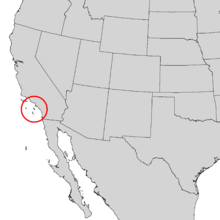Cercocarpus traskiae
| Cercocarpus traskiae | |
|---|---|

| |
| Scientific classification | |
| Kingdom: | Plantae |
| Clade: | Tracheophytes |
| Clade: | Angiosperms |
| Clade: | Eudicots |
| Clade: | Rosids |
| Order: | Rosales |
| Family: | Rosaceae |
| Genus: | Cercocarpus |
| Species: | C. traskiae
|
| Binomial name | |
| Cercocarpus traskiae | |

| |
| Natural range of Cercocarpus traskiae | |
Cercocarpus traskiae, known by the common names Santa Catalina Island mountain-mahogany and Catalina mahogany, is a rare species of plant in the rose family.
Distribution[]
It is endemic to Catalina Island, one of the southern Channel Islands in Los Angeles County, California. It is known from just a single population,[1] found in Wild Boar Gully, an arroyo covered in coastal sage scrub on Catalina Island.[2] The steep sides of the arroyo contain soils of saussurite gabbro.[1][2]
It was rare when it was first discovered by in 1897[3] or 1898,[1] when about 40[3] to 50[1] plants were counted.[2]
When it was federally listed as an endangered species, in 1996, there were only six mature plants remaining.[1] It has been called "one of the rarest shrubs in the continental United States"[3] and "one of the rarest trees in North America."[2]
Description[]
Cercocarpus traskiae is a large shrub or tree that grows up to 8 meters in height. The leaves have thick, leathery oval blades with serrated edges and woolly-haired undersides. The leathery, woolly texture of the leaves distinguishes it from other Cercocarpus.[4] The inflorescence is a cluster of up to 10 flowers which do not have petals. Plants do not always flower each year.[2]
While there are sometimes many seedlings noted, the seedling survival rate and rate of recruitment are quite low.[2] As of 2007, there are only seven adult trees capable of reproduction, all located in Wild Boar Gully, and most of these are very old.[2]
Conservation[]
The Catalina Island mountain mahogany is threatened by ungulates such as deer, and feral goats and pigs.[2] The goats have been removed from the island, and fencing has been placed to prevent the remaining animals from touching the plants.[2]
This rare species hybridizes with its relative, Cercocarpus betuloides, a situation that may lead to genetic swamping of the rare plant.[4] This hybridization may be made more likely by the animals' disturbance of the habitat.[2] Many of the seedlings and saplings growing today may be hybrids.[2]
The population of pure Cercocarpus traskiae is not increasing and the species is entirely dependent on human intervention today.[2][5]
See also[]
References[]
- ^ Jump up to: a b c d e "Comprehensive Report Species - Cercocarpus traskiae". NatureServe. The Nature Conservancy. August 2010. Retrieved January 2011. Check date values in:
|accessdate=(help) - ^ Jump up to: a b c d e f g h i j k l USFWS. Cercocarpus traskiae Five Year Review. September 2007.
- ^ Jump up to: a b c "National Collection of Imperiled Plants - Plant Profile: Cercocarpus traskiae". Center for Plant Conservation, Missouri Botanical Garden, St. Louis, Missouri. March 2010. Archived from the original on 2010-12-15. Retrieved January 2011. Check date values in:
|accessdate=(help) - ^ Jump up to: a b Rieseberg, L. H. and D. Gerber. (1995). Hybridization in the Catalina Island mountain mahogany (Cercocarpus traskiae): RAPD evidence. Archived September 28, 2010, at the Wayback Machine Conservation Biology 9:1 199.
- ^ IUCN Red List of Threatened Species: Cercocarpus traskiae; World Conservation Monitoring Centre (1998) . downloaded on 30 January 2011.
External links[]
- IUCN Red List critically endangered species
- Cercocarpus
- Endemic flora of California
- Natural history of the Channel Islands of California
- Natural history of the California chaparral and woodlands
- Natural history of Los Angeles County, California
- Santa Catalina Island (California)
- Critically endangered flora of California
- NatureServe critically imperiled species
